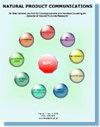利用血清药物化学和网络药理学鉴定少腹逐瘀汤治疗子宫内膜异位症的潜在生物活性成分和靶点
IF 1.4
4区 医学
Q4 CHEMISTRY, MEDICINAL
引用次数: 0
摘要
方法采用超高效液相色谱-四极杆飞行时间质谱(UPLC-Q-TOF-MS)鉴定子宫内膜异位症模型大鼠血清样本中的少腹逐瘀汤原型成分。根据血液中的原型成分,网络药理学筛选出 SFZYD 在体内的潜在生物活性成分、靶点和关键通路。结果 利用 UPLC-Q-TOF-MS 对 SFZYD 的 170 种成分进行了体外表征,并在大鼠血清中鉴定出 SFZYD 的 40 种原型成分。根据这些原型,网络药理学预测了与EMs相关的90个蛋白质靶点和193条通路。筛选出 SFZYD 中具有潜在生物活性的五种成分,并确定了四个核心靶点,这些成分是反式-4-羟基肉桂酸、对甲氧基肉桂酸乙酯、阿魏酸、原阿魏酸和 3,5-O-二咖啡酰奎宁酸,而确定的核心靶点是 ESR1、表皮生长因子受体、SRC 和 MAPK1。本研究阐明了 SFZYD 中的 13 种活性成分通过调节 ESR1、表皮生长因子受体(EGFR)、SRC 和 MAPK1 四种核心靶点,通过多种信号通路治疗 EMs,具有多靶点、多成分和协同作用,可作为开发治疗 EMs 新药的参考和依据。本文章由计算机程序翻译,如有差异,请以英文原文为准。
Identifying Potential Bioactive Components and Targets of Shaofuzhuyu Decoction in Treating Endometriosis Using serum Pharmacochemistry and Network Pharmacology
ObjectiveTo evaluate the underlying pharmacodynamics and therapeutic mechanism of Shaofuzhuyu Decoction (SFZYD) in treating Endometriosis (EMs).MethodsUltra-performance liquid chromatography-quadrupole time-of-flight mass spectrometry (UPLC-Q-TOF-MS) was employed to identify prototype ingredients of SFZYD in serum samples of EMs model rats. SFZYD was screened by Network Pharmacology for potential bioactive components, targets and key pathways in vivo according to the prototype components in blood. Subsequently, the binding activities of the potential bioactive compounds and key targets were tested by molecular docking techniques.Results170 components of SFZYD were characterized in vitro using UPLC-Q-TOF-MS, and a total of 40 prototype ingredients of SFZYD were identified in rat serum. Network pharmacology predicted 90 protein targets and 193 pathways associated with EMs based on these prototypes. Five components of SFZYD were screened as potential biological activities, and four core targets were identified, these components were trans-4-hydroxycinnamic acid, ethyl p-methoxycinnamate, ferulic acid, protoferulic acid, and 3,5-O-dicaffeoylquinic acid, while the identified core targets were ESR1, EGFR, SRC, and MAPK1. Vigorous binding activities between potential bioactive components and the core targets were demonstrated by molecular docking studies.ConclusionThe present study elucidated that 13 active components in SFZYD act to treat EMs by regulating four core targets, ESR1, EGFR, SRC and MAPK1, through multiple signalling pathways, and have multi-target, multi-component and synergistic effects, which may serve as a reference and basis for the development of new drugs for treating EMs.
求助全文
通过发布文献求助,成功后即可免费获取论文全文。
去求助
来源期刊

Natural Product Communications
工程技术-食品科技
CiteScore
3.10
自引率
11.10%
发文量
254
审稿时长
2.7 months
期刊介绍:
Natural Product Communications is a peer reviewed, open access journal studying all aspects of natural products, including isolation, characterization, spectroscopic properties, biological activities, synthesis, structure-activity, biotransformation, biosynthesis, tissue culture and fermentation. It covers the full breadth of chemistry, biochemistry, biotechnology, pharmacology, and chemical ecology of natural products.
Natural Product Communications is a peer reviewed, open access journal studying all aspects of natural products, including isolation, characterization, spectroscopic properties, biological activities, synthesis, structure-activity, biotransformation, biosynthesis, tissue culture and fermentation. It covers the full breadth of chemistry, biochemistry, biotechnology, pharmacology, and chemical ecology of natural products.
Natural Product Communications is a peer reviewed, open access journal studying all aspects of natural products, including isolation, characterization, spectroscopic properties, biological activities, synthesis, structure-activity, biotransformation, biosynthesis, tissue culture and fermentation. It covers the full breadth of chemistry, biochemistry, biotechnology, pharmacology, and chemical ecology of natural products.
 求助内容:
求助内容: 应助结果提醒方式:
应助结果提醒方式:


